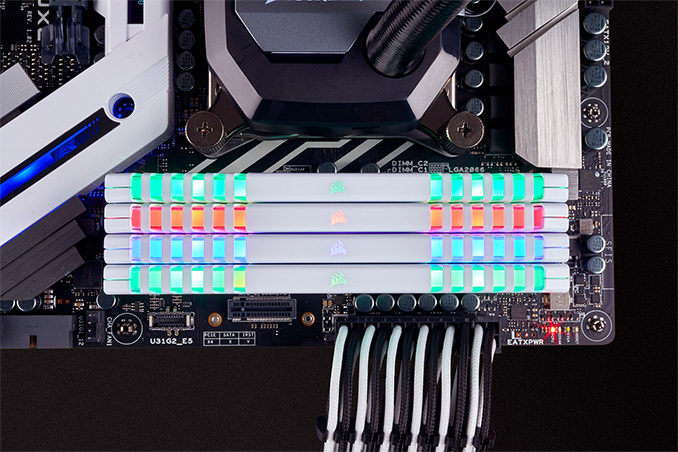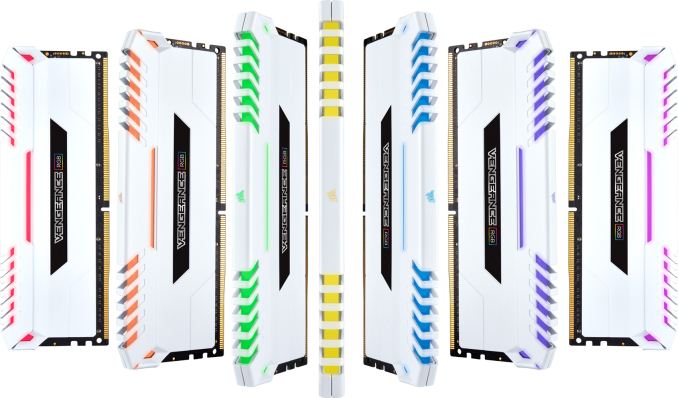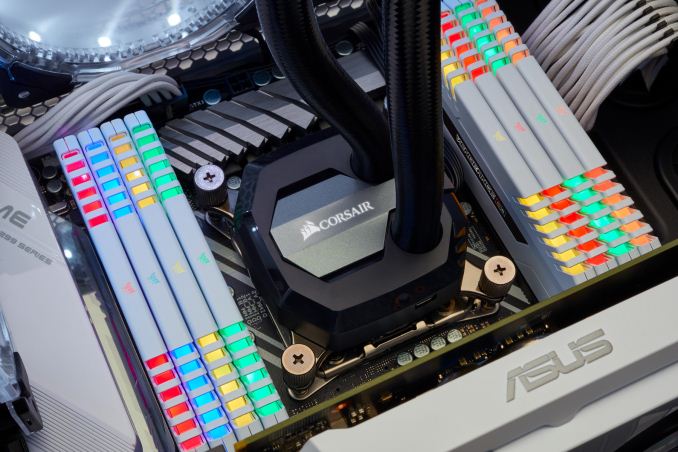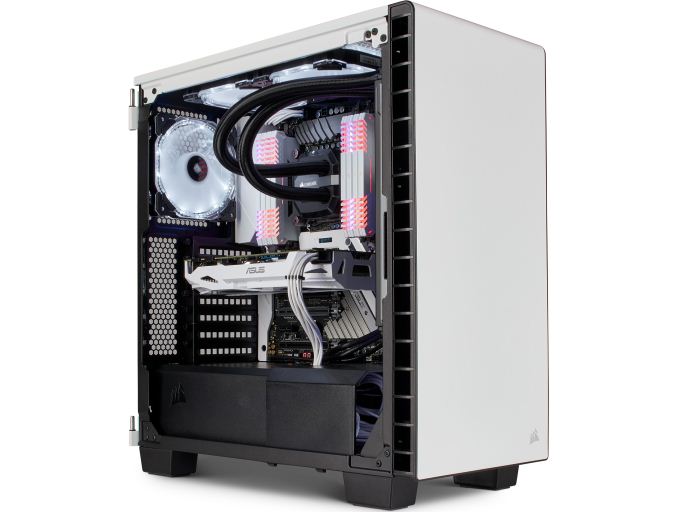Corsair Weds RGB Lighting and White Heat Spreaders in Vengeance RGB White DDR4 DIMMs
by Anton Shilov on September 30, 2017 10:00 AM EST- Posted in
- Memory
- Corsair
- DDR4
- RGB
- Vengeance RGB
- Vengeance RGB White

Corsair has once again expanded its lineup of Vengeance RGB memory modules, this time with a new series of white DIMMs that incorporate RGB lighting. Dubeed the Vengeance RGB White, these sticks are aimed at modders building white systems with RGB enhancements. The new DIMMs cover a broad range of speeds and capacities, with 16, 32 and 128 GB DDR4 dual- and quad-channel kits running at 3000, 3200 and 3600 MT/s data transfer rates.
White is becoming more popular among modders these days. Over the past several years, we have seen multiple white motherboards and computer cases, but other components like PSUs, graphics cards and memory modules came in white relatively rarely. By contrast, over the past few months, we have seen an uptick in the number of launches of products in white enclosures, including PSUs. Being one of the most prominent supporters of white components, which has offered white PC cases for more than five years, it seems only fitting that Corsair has taken the next step by offering white DIMMs.
The Corsair Vengeance RGB White family of memory modules consists of 8 GB and 16 GB DIMMs (supposedly based on Samsung’s B-die ICs) running at DDR4-3000 CL15, DDR4-3200 CL16 and DDR4-3600 CL18 speeds. The modules require 1.35V, so an enthusiast-class motherboard that can increase DDR4 voltages is necessary. Like other Vengeance-series modules, the Vengeance RGB White DDR4 kits come with XMP 2.0 SPD profiles to make their setup easier on Intel's X99, Z170, Z270, Z370 and X299 platforms.
| Corsair Vengeance RGB White DDR4 DIMMs and Kits | |||||||||
| Data rate | Latency | Kit Capacity | Modules | Voltage | Part Number | Launch Price | |||
| 3000 MT/s | CL15 17-17-36 | 16 GB | 2x8GB | 1.35 V | CMR16GX4M2C3000C15W | $189.99 | |||
| CL15 17-17-35 | 32 GB | 4x8GB | CMR32GX4M4C3000C15W | $374.99 | |||||
| CL16 18-18-36 | 128 GB | 8x16GB | CMR128GX4M8C3000C16W | $1469.99 | |||||
| 3200 MT/s | CL16 18-18-36 | 16 GB | 2x8GB | CMR16GX4M2C3200C16W | $199.99 | ||||
| 32 GB | 2x16GB | CMR32GX4M2C3200C16W | $379.99 | ||||||
| 32 GB | 4x8GB | CMR32GX4M4C3200C16W | $399.99 | ||||||
| 3600 MT/s | CL18 19-19-39 | 16 GB | 2x8GB | CMR16GX4M2C3600C18W | $204.99 | ||||
Just like their brethren from the original Vengeance RGB family with black heat spreaders, the Vengeance RGB White modules plug into regular DIMM slots and do not require any additional cables for RGB lighting. The latter can be controlled using the Corsair Link software, allowing users to synchronize colors of RGB lighting of their DIMMs and specific motherboard brands. Lighting of each module can be controlled separately as well. Besides, the RGB lighting can also be tuned using appropriate programs from manufacturers of motherboards — the ASUS Aura Sync, the GIGABYTE RGB Fusion and the MSI Mystic Light.
The Corsair Vengeance RGB White lineup is now available directly from Corsair and from its resellers worldwide. Since we are dealing with unique products for enthusiasts/modders, they come at a premium price. For example the 16 GB DDR4-3200 CL16 and the 16 GB DDR4-3600 CL18 kits cost $199.99 and $204.99, respectively. The 32 GB kits are priced from from $374.99 to $399.99, whereas the 128 GB kit is available for $1469.99.
Related Reading:
- Corsair Announces White Color Option for RM750x and RM850x Power Supplies
- Corsair Vengeance RGB DDR4 Memory Modules with LEDs Now on Sale
- Corsair Announces 16GB DDR4-4600 Vengeance LPX DRAM Kits
- DRAM and Motherboard Makers Demonstrate Quad-Channel DDR4-4000+ Operation
- The Corsair Neutron NX500 (400GB) PCIe SSD Review: Big Card, Big Pricetag
Source: Corsair



















35 Comments
View All Comments
jospoortvliet - Sunday, October 1, 2017 - link
HahaYes and western is buying it like drugs...
Gothmoth - Saturday, September 30, 2017 - link
by the way.convection only happens when there is no airflow.
when you have a case fan convection does nothing.
it´s a thing often missunderstood by people with no background in physics.
FullmetalTitan - Saturday, September 30, 2017 - link
ConductionThe word you were looking for was conduction.
And conduction happens so long as there is a fluid medium with which to exchange phonons of heat energy, while convection requires movement of said fluid medium, greatly increasing heat dissipation.
Conduction is ALWAYS happening so long as there is a temperature difference (and you aren't in a vacuum).
ddriver - Saturday, September 30, 2017 - link
Yep, that's why contrary to some sci-fi, you don't immediately freeze up in space even thou it is ultra cold. There is no atmosphere to conduct heat away from you, absent any fluid medium you can only lose heat by infrared emission.ddriver - Saturday, September 30, 2017 - link
Convection will also occur if there is airflow, but its mechanics will be disturbed by it. If there is gas, it will heat, thus its density will drop and it will rise, causing negative pressure, which will suck in colder and denser gas. Convection causes airflow too, just in a different manner a fan does.Ram modules are usually oriented in such a way that they'd be perpendicular to the airflow, I mean the flow that goes through the CPU radiator and out the case rear. In this aspect, case fans aren't really doing much good as the orientation results in dead spots, which is where convection kicks in, ram sticks usually being vertical, they'd suck cold air in the gaps between them from the bottom and push it up.
Cases with fans on the top are a tad better, as they will create some airflow that is parallel to the ram modules and could get in the gaps between them. But many cases do not have those.
Of course, the lack of gaps between the modules doesn't help fan-made airflow neither.
versesuvius - Saturday, September 30, 2017 - link
That is supposedly how multiple 400 watt blower type Nvidia cards get cooled. By case fans that sound like jet engines, that is. I am skeptical of that explanation but that is how it is generally explained.bigboxes - Saturday, September 30, 2017 - link
Proves we don't need heat spreaders.Flunk - Sunday, October 1, 2017 - link
RAM doesn't get hot, the heatspreader is just there for looks. Heatspreaders don't do much unless they're attached to a heatsink anyway.DanNeely - Saturday, September 30, 2017 - link
I applaud Corsair for being willing to release these. Not because I'm a fan of white (meh) or RGB (cancer); but because by designing "heat sinks" that seal off the center two dimms from any airflow or ability to radiate heat from the sides they've demonstrated how utterly useless they are.ddriver - Saturday, September 30, 2017 - link
It actually might have taken a lot more engineering than apparent. However, they did not put it into making the product durable and reliable, but by carefully engineering it to under-perform thermally on purpose, timed to cut the product lifetime to a desired period, usually just after the warranty period expires. You promote extra sales this way.